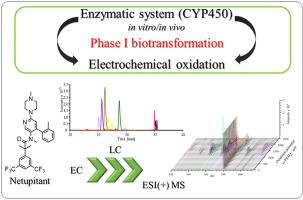Journal of Pharmaceutical Analysis ( IF 6.1 ) Pub Date : 2021-04-01 , DOI: 10.1016/j.jpha.2021.03.011 Ruxandra Chira 1 , Jens Fangmeyer 2 , Ioan O Neaga 1 , Valentin Zaharia 3 , Uwe Karst 2 , Ede Bodoki 1 , Radu Oprean 1

|
Considering the frequent use of netupitant in polytherapy, the elucidation of its oxidative metabolization pattern is of major importance. However, there is a lack of published research on the redox behavior of this novel neurokinin-1 receptor antagonist. Therefore, this study was performed to simulate the intensive hepatic biotransformation of netupitant using an electrochemically driven method. Most of the known enzyme-mediated reactions occurring in the liver (i.e., N-dealkylation, hydroxylation, and N-oxidation) were successfully mimicked by the electrolytic cell using a boron-doped diamond working electrode. The products were separated by reversed-phase high-performance liquid chromatography and identified by high-resolution mass spectrometry. Aside from its ability to pinpoint formerly unknown metabolites that could be responsible for the known side effects of netupitant or connected with any new perspective concerning future therapeutic indications, this electrochemical process also represents a facile alternative for the synthesis of oxidation products for further in vitro and in vivo studies.
中文翻译:

通过电化学耦合质谱法模拟 NK1 受体拮抗剂 netupitant 的氧化代谢模式
考虑到 netupitant 在多药治疗中的频繁使用,阐明其氧化代谢模式非常重要。然而,缺乏关于这种新型神经激肽-1 受体拮抗剂的氧化还原行为的已发表研究。因此,进行这项研究是为了使用电化学驱动方法模拟 netupitant 的密集肝脏生物转化。大多数已知的酶介导反应发生在肝脏(即N-脱烷基化、羟基化和N-氧化)通过使用掺硼金刚石工作电极的电解池成功模拟。产物经反相高效液相色谱分离,高分辨质谱鉴定。除了能够查明可能导致 netupitant 的已知副作用或与有关未来治疗适应症的任何新观点相关的以前未知的代谢物的能力之外,这种电化学过程还代表了一种简便的替代方法,用于合成氧化产物,用于进一步的体外和体内研究。











































 京公网安备 11010802027423号
京公网安备 11010802027423号